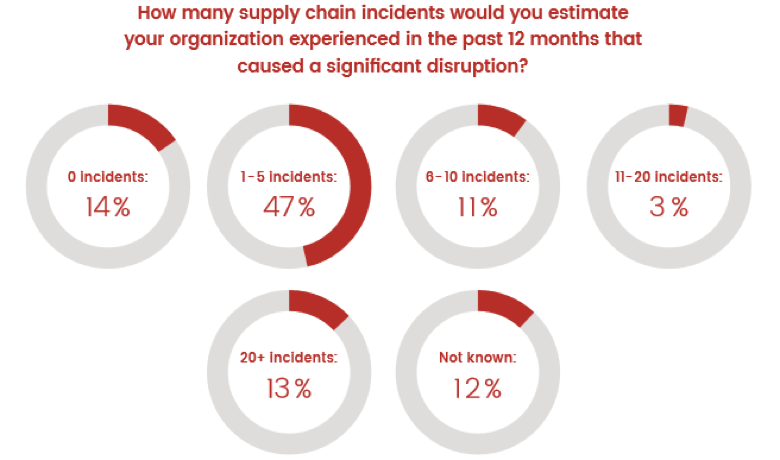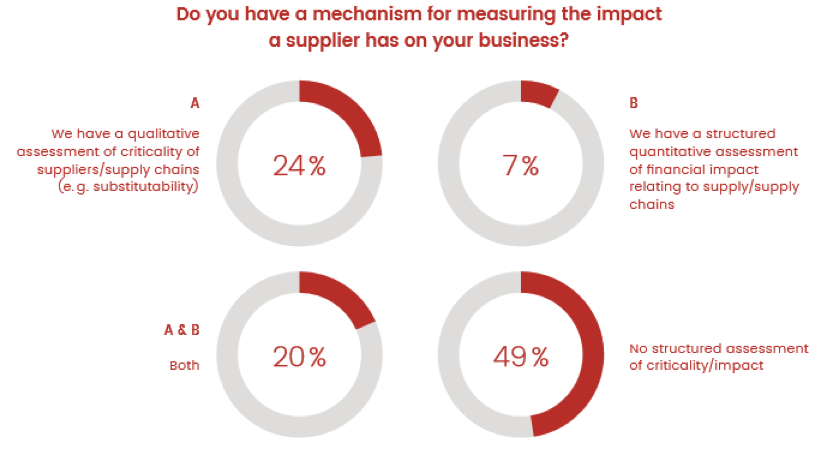4 Ways Procurement Could Better Manage Risk
Procurement pros need to get better at managing risk. Because supply chain disruption can come from any angle, whether it’s caused by a supplier site failure, environmental or geopolitical factors, or even adverse weather…

If it’s not already, risk management should be a top priority for businesses. The consequences from not actively identifying, managing and mitigating supply chain risk can significantly impact an organisation’s profitability, not to mention brand reputation and potentially, its sheer existence.
riskmethods set out to determine the current “state of risk management and mitigation” in today’s global business ecosystem by surveying more than 250 senior procurement executives from across the globe. The study unveiled important findings around how prepared procurement leaders are to tackle rapidly evolving business environments brought on by new, more complex threats, and the current methodologies employed to manage risk in the supply chain. Here are four areas the survey explored, which indicate where procurement teams are failing in terms of risk management.
-
Preventing disruption
All senior procurement professionals identify ‘avoiding significant disruption to the supply chain’ as a top priority, but when survey respondents were asked whether their organisation had a significant disruption in the past 12 months, more than 47 per cent indicated that they had experienced between one and five.
Additionally, a surprisingly high 13 percent indicated that they had 20 or more significant disruptions in the past year. Arguably the most alarming statistic – 12 per cent of respondents did not even know whether there were any serious disruptions to their supply chain during this time.
This is a testament to the 12 per cent’s minimal visibility into their operations. According to this data, nearly all organisations faced a disruption in the past year, speaking to the prevalence and nature of supply chain threats at they continue to increase.

-
Improve ability to uncover risks
The current landscape has made it critical for procurement professionals to have real-time, thorough views into potential risk and their impacts to make well-informed purchasing decisions. Many organisations have implemented some form of tracking mechanism for risks, but how often the data is updated is another issue.
When we asked respondents about the frequency in which data is refreshed, less than one third of respondents answered continuously. This is an alarming percentage.
Risk monitoring in today’s digital business environment needs to be a 24/7/365 task. Organisations that aren’t receiving continuous updates are falling behind and can’t possibly be making the best decisions for their business.
The underlying cause of this lack of complete information is usually associated with traditionally highly manual processes. Not only is the manual approach an extremely tedious and time-consuming task, it also takes away resources from other critical objectives. Most importantly, it severely limits big-picture insights and increases the chances of a serious supply chain disruption. When survey respondents were asked what level of automation their organisation employed to refresh critical information, less than one per cent of respondents indicated that it is completely automated.
An additional 39 per cent indicated that they were in the low to moderate rage of automation, relying heavily on manual tools such as Excel in conjunction with some outside sources. A full quarter of respondents indicated that they have no automation capabilities at all and are completely reliant upon manual search.
-
Supplier risk impact assessments are key
Understanding a supplier’s potential impact on the business is key for procurement teams when it comes making purchasing decisions. For example, if a major supplier gets hit by a severe weather event which causes a delay in shipping, that could cause a ripple effect that halts production and eventually leads to a loss in revenue.
When survey participants were asked if their organisation had a mechanism in place for measuring the impact a supplier has on the business, almost half said that their organisation had no structured assessment of supplier criticality or impact.
Having no such assessment means organisations are at times putting their fate in the control of someone’s best guess. Organisations must have clear visibility into their supply chain, including which suppliers have the greatest potential impact, so they can refocus resources on reducing risk and preparing for a crisis.

-
Organisations must be better equipped to mitigate emerging threats
While being able to identify potential risk is a crucial procurement workflow, having the ability to act on that information and mitigate evolving threats is equally, if not more, important.
Only slightly more than 20 per cent of study respondents indicated they have plans in place. An additional 27 per cent indicated that no such plans exist and 53 per cent indicated that there were only partial plans in place. These numbers demonstrate how difficult it is to evolve into a mature organisation when it comes to prioritising risk because businesses lack the necessary level of stakeholder collaboration.
Supply chains will never be free of risks, but an organisation’s ability to prepare for, identify and mitigate emerging threats will set them apart from the competition. Procurement teams can’t possibly make well-informed business decisions without a risk management strategy in place. As the number of risks continues to increase in this environment, the need for accurate, actionable insights will only become more critical.
When it comes to risk management, companies need to consistently be moving forward as the current threats will only continue to evolve.
Download the report: Procuring Risk: The State of Risk Management and Mitigation in Today’s Global Supply Chain to read riskmethods’ full findings.